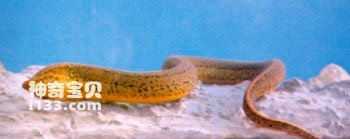Monopterus albus belongs to the order Synbranchidae, the family Synbranchidae, and the genus Monopterus. Commonly known as: eel, eel, eel, snake fish. English name: Ricefield eel.
The body is slender and serpentine-shaped, with round front and flat sides at the rear, and a tapered tail. The head is long and round. The mouth is large, end-positioned, the upper jaw is slightly protruding, and the lips are well developed. There are fine teeth on the upper and lower jaws and the bones of the mouth. The eyes are small and covered by a thin skin. The left and right gill openings merge into one on the ventral surface, forming an inverted "V" shape. The gill membrane is connected to the gill isthmus. The body is lubricated and scale-free. There are no pectoral fins and pelvic fins; the dorsal fin and anal fin have degenerated, leaving only skin folds and no soft spines, both of which are combined with the caudal fin. When alive, the eel's body is yellowish-brown with irregular black spots. The body color of the eel often varies with the environment in which it lives.

Monopterus eel is a fish in tropical and warm temperate zones. It is a bottom-dwelling fish and has strong adaptability. It can survive in rivers, lakes, ditches and rice fields. During the day, it likes to drill holes in humus-rich mud or burrow in rock gaps with water on banks. They rarely move during the day and come out of their burrows to look for food at night. The gills are underdeveloped, but they rely on the inner wall of the mouth and throat as auxiliary organs for breathing. They can breathe air directly; they can also survive when the oxygen content in the water is very poor. After getting out of the water, as long as the skin is kept moist, death will not occur within a few days. Monopterus eel is an omnivorous fish that feeds on various small animals. It is greedy and feeds most vigorously in summer. In cold seasons, it can go without food for a long time without dying.
The reproductive season of eels is about June to August. In its ontogeny, it has the characteristics of male and female reversal, that is, it is female from the embryonic stage to the first sexual maturity (that is, the gonads of individuals with a body length of less than 35 cm are all ovaries). ); after laying eggs, the ovary gradually turns into a testis; when the body length is 36-48 cm, the sex is partially reversed, and the male and female individuals are almost equal; those that grow to more than 53 cm are mostly testes. At that time, the young fish could only grow to 20 centimeters, and the 2-winter-old female fish only reached maturity, with a body length of at least 34 centimeters. The largest individual can reach 70 cm and weigh 1.5 kg. Monopterus eels lay eggs near the entrance of their burrows. Before laying eggs, they spit foam from their mouths and build a nest. The fertilized eggs develop on the water surface with the help of the buoyancy of the foam. Both male and female fish have the habit of protecting the nest.
Distributed in southeastern Asia, this fish is found in all waters across the country except the western plateau. Abroad, it reaches western Korea, southern Japan, the Philippines, Java and Myanmar. The eel meat is tender and delicious. The nutritional value is very high. Each 100 grams of eel meat contains 17.2-18.8 grams of protein, 0.9-1.2 grams of fat, 38 mg of calcium, 150 mg of phosphorus, and 1.6 mg of iron; in addition, it also contains thiamine (vitamin B1), riboflavin ( B2), niacin (vitamin PP), ascorbic acid (vitamin C) and other vitamins. Monopterus eel is not only used as a famous dish to entertain guests. In recent years, it has been exported live and sold well abroad. Frozen eels are also exported to America and other places. Monopterus eels are produced all year round, but the ones before and after Xiaoshu are the most plump. There is a folk saying that "Small Heat eels are better than ginseng".
The eel is not only a delicacy, but its meat, blood, head and skin all have certain medicinal value. According to the "Compendium of Materia Medica", eel has the functions of nourishing blood, nourishing qi, anti-inflammatory, disinfecting, and removing rheumatism. Eel meat is sweet and warm in nature and has the effect of nourishing the body, nourishing the blood, and treating deficiency. It is used as folk medicine to treat fatigue cough, damp-heat itching, intestinal wind, hemorrhoids, and deafness. Burning eel head into ashes and taking it with warm wine on an empty stomach can cure hard and painful breast nuclei in women. Its bones are used as medicine to treat ecthyma, and the curative effect is quite remarkable. When its blood is dripped into the ears, it can cure chronic suppurative otitis media; when dripped into the nose, it can cure epistaxis (nose bleeding); especially when used externally, it can cure mouth and eye deviation and facial nerve paralysis. Eel serum is poisonous, but the toxin is not heat-resistant and can be destroyed by gastric juice and heating. Generally, poisoning will not occur when cooked and eaten. Whether eel blood is used to treat diseases among the people is caused by toxins in the blood remains to be studied in depth.
animal tags:
We created this article in conjunction with AI technology, then made sure it was fact-checked and edited by a Animals Top editor.